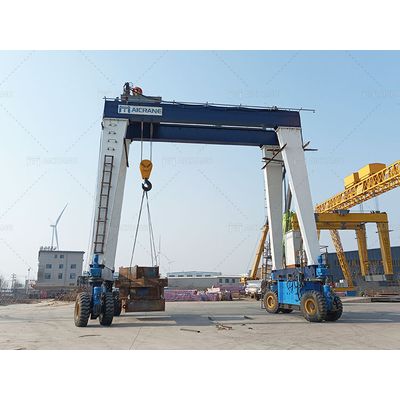


Electrification Trends in RTG Cranes: A Green Future
The global focus on sustainability and reducing carbon emissions has spurred a paradigm shift in industries worldwide. Among the most notable changes is the move toward electrification in container handling equipment, particularly Rubber Tyred Gantry (RTG) cranes. As ports and terminals seek greener, more efficient operations, electrified RTG cranes are emerging as a cornerstone of this transition. This article delves into the trends driving the electrification of RTG cranes, their benefits, and their role in shaping a greener future for the logistics and shipping industries.
The Push Toward Sustainability
Ports are critical hubs for global trade but are also significant contributors to greenhouse gas emissions. Traditional RTG cranes, powered by diesel generators, are known for their high fuel consumption and emissions. The International Maritime Organization (IMO) and other regulatory bodies have implemented stringent environmental standards, compelling port operators to explore cleaner alternatives. Electrification is one of the most promising solutions to meet these requirements while enhancing operational efficiency.
Understanding Electrified RTG Cranes
Electrified RTG cranes replace diesel generators with electric power sources, either through grid connections or battery systems. The two primary approaches to RTG crane electrification include:
E-RTG (Electric RTG): These cranes draw power directly from the grid via cable reels, conductor bars, or festoon systems. E-RTGs eliminate the need for onboard diesel engines, significantly reducing emissions and noise levels.
Hybrid RTG: These cranes combine diesel engines with energy storage systems, such as lithium-ion batteries. The batteries store energy during operations, which can then power the crane during periods of low activity, reducing fuel consumption and emissions.
Key Drivers of Electrification Trends
1. Environmental Regulations
Governments and international organizations are enforcing stricter regulations to curb carbon emissions. Electrified RTGs help port operators comply with these standards, ensuring sustainable operations without compromising efficiency.
2. Cost Efficiency
While the initial investment in electrified RTG cranes is higher, the long-term operational savings are substantial. Reduced fuel costs, lower maintenance requirements, and energy-efficient operations translate to significant financial benefits.
3. Technological Advancements
Innovations in battery technology, power management systems, and energy-efficient designs have made electrification more feasible and cost-effective. Modern electrified RTGs boast improved performance, reliability, and ease of integration into existing port infrastructure.
4. Corporate Sustainability Goals
Many port operators and logistics companies are adopting ambitious sustainability targets. Electrification aligns with these goals, enhancing brand reputation and meeting stakeholder expectations for green operations.
Benefits of Electrified RTG Cranes
1. Reduced Carbon Footprint
Switching to electric power significantly cuts greenhouse gas emissions. E-RTGs, for instance, produce zero on-site emissions, contributing to cleaner air and reduced environmental impact.
2. Lower Noise Levels
Diesel engines are notorious for their noise pollution. Electrified RTGs operate quietly, creating a safer and more comfortable environment for port workers and nearby communities.
3. Enhanced Energy Efficiency
Electric systems are inherently more efficient than their diesel counterparts. Hybrid RTGs, for example, recover energy during braking and lowering operations, maximizing energy utilization.
4. Operational Savings
Electric RTGs require less maintenance compared to diesel-powered cranes. The absence of engines and fuel systems reduces wear and tear, lowering operational costs over the crane’s lifecycle.
5. Future-Proofing Ports
As global trade volumes increase, ports must adapt to growing demands while minimizing their environmental impact. Electric gantry cranes provide a scalable solution, ensuring ports remain competitive and compliant with future regulations.
Challenges in Electrification
Despite their benefits, the transition to electrified RTGs comes with challenges:
High Initial Costs: The upfront investment in electrified cranes and supporting infrastructure can be a deterrent for some operators.
Infrastructure Requirements: E-RTGs require robust electrical infrastructure, including power supply systems and grid connections, which may necessitate significant upgrades.
Energy Storage Limitations: For hybrid RTGs, battery capacity and lifespan are critical factors. Advancements in battery technology are addressing these concerns but remain a work in progress.
Real-World Applications
Several ports have already embraced electrified RTG cranes as part of their sustainability strategies:
Port of Los Angeles, USA: The port has adopted E-RTGs as part of its Clean Air Action Plan, significantly reducing emissions and improving air quality.
Port of Rotterdam, Netherlands: Known for its innovative approaches, the port has deployed hybrid RTGs, combining efficiency with sustainability.
Shanghai Port, China: One of the world’s busiest ports, Shanghai has incorporated electrified RTGs to meet its ambitious environmental targets.
Future Outlook
The electrification of RTG cranes is poised to accelerate as technology continues to advance and environmental regulations tighten. Key trends shaping the future include:
Energy Storage Innovations: Breakthroughs in battery technology will enhance the performance and cost-effectiveness of hybrid RTGs.
Integration with Renewable Energy: Ports are increasingly adopting renewable energy sources, such as solar and wind, to power electrified equipment, further reducing their carbon footprint.
Automation and Digitization: Electrified RTGs are well-suited for integration with automated and digital systems, enabling smarter, more efficient port operations.
Conclusion
The shift toward electrified RTG cranes represents a significant step forward in creating sustainable, efficient, and future-ready ports. While challenges remain, the benefits far outweigh the drawbacks, offering a compelling case for electrification. As ports worldwide embrace these innovations, electrified RTG cranes will undoubtedly play a pivotal role in shaping a greener future for global trade.
